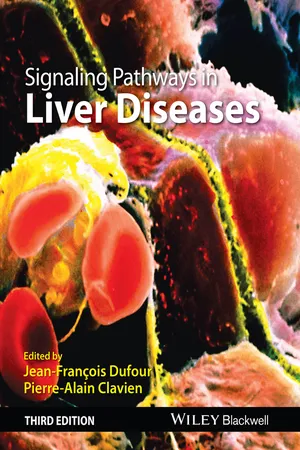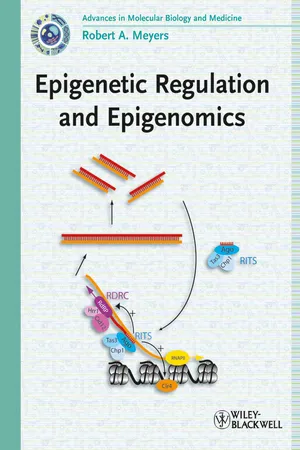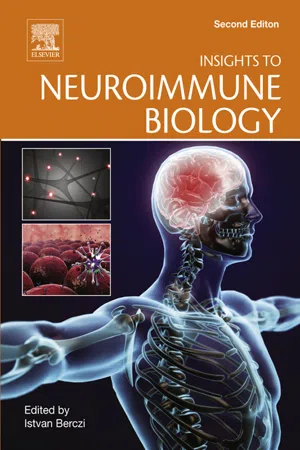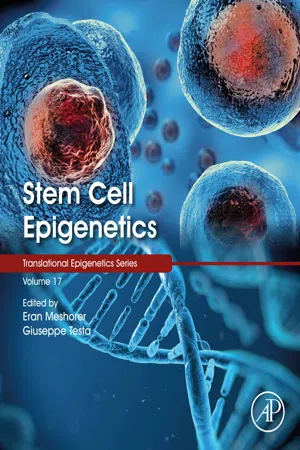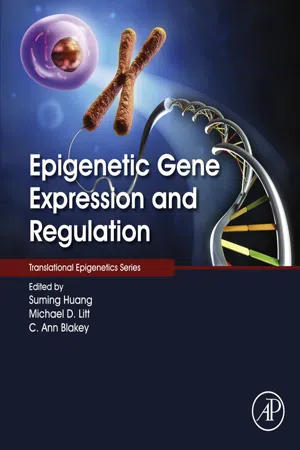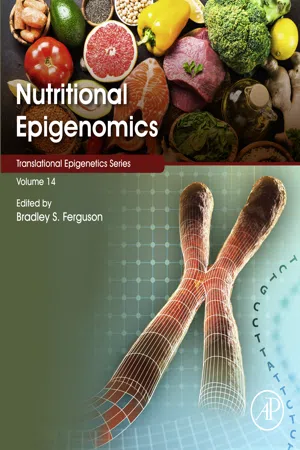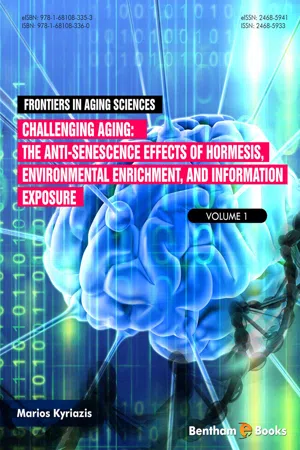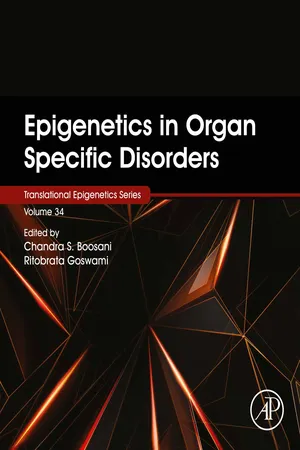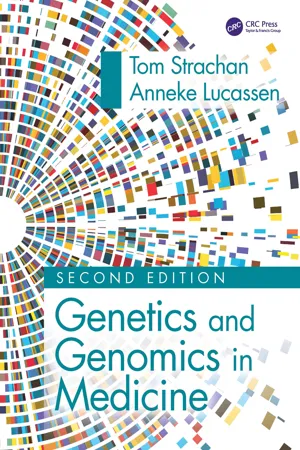Biological Sciences
Epigenetic Regulation of Stem Cells
Epigenetic regulation of stem cells refers to the control of gene expression and cellular identity through chemical modifications to DNA and histone proteins, rather than changes in the underlying DNA sequence. This regulation plays a crucial role in determining the fate and function of stem cells, influencing their differentiation into various cell types and their self-renewal capacity.
Written by Perlego with AI-assistance
Related key terms
Related key terms
1 of 4
Related key terms
1 of 3
11 Key excerpts on "Epigenetic Regulation of Stem Cells"
- Kerry Atkinson(Author)
- 2016(Publication Date)
- Wiley-Blackwell(Publisher)
Chapter 6 Epigenetic Regulation of Mesenchymal Stem/Stromal Cell Growth and Multipotentiality Sarah Elizabeth Hemming,a,b Dimitrios Cakouros,a,b and Stan Gronthos* a,ba Mesenchymal Stem Cell Laboratory, School of Medical Sciences, Faculty of Health Sciences, University of Adelaide, South Australia, Australiab Cancer Theme, South Australian Health and Medical Research Institute, Adelaide, SA, AustraliaChapter Menu
- 6.1 Introduction
- 6.2 Mesenchymal Stromal/Stem Cells
- 6.3 Epigenetics
- 6.4 DNA Methylation and Histone Modifications in Mesenchymal Stem/Stromal Cells
- 6.5 Epigenetic Regulation of Osteogenic Differentiation
- 6.6 Epigenetic Regulation of Adipogenic Differentiation
- 6.7 Epigenetic Regulation of Myogenic Differentiation
- 6.8 Epigenetic Regulation of Chondrogenic Differentiation
- 6.9 Epigenetic Regulation of Mesenchymal Stem/Stromal Cell Lifespan and Senescence
- 6.10 Regulation of Epigenetic Modifications in Mesenchymal Stem/-Stromal Cells for Clinical Use
- 6.11 Conclusions
- References
6.1 Introduction
Mesenchymal stem/stromal cells (MSC s) are considered to be a reliable source of stem cells for cellular-based regenerative medicine applications owing to their multipotent potential, proangiogenic, and immunomodulatory properties. While the use of MSCs is less controversial than embryonic-derived stem cells (ESC s), they, like all somatic stem cells, have a finite lifespan ex vivo- eBook - ePub
- Jean-Francois Dufour, Pierre-Alain Clavien(Authors)
- 2015(Publication Date)
- Wiley-Blackwell(Publisher)
Berger and colleagues also proposed three distinct categories of step-wise signals that define the mechanistic components of epigenetic transmission [9]. The first is the “epigenator” which transiently responds to a change in the environment and triggers the epigenetic phenotype; for example, a ligand-receptor interaction at the cell surface, a change in temperature, altered dietary factors or a xenobiotic insult. The second step is the epigenetic “initiator” which is primed by the epigenator and mediates the required epigenetic changes; examples include DNA or RNA binding proteins, noncoding RNAs, and signal transduction molecules. The third step is engagement of the epigenetic “maintainer” signals, which include DNA (CpG) methylation, modification of histone tails, histone variants, and nucleosome remodelers. We therefore now understand epigenetics to be the study of the biological processes that have evolved to provide exquisite dynamic control of gene expression, enabling precise and stable modulation of cell phenotype in response to environmental cues such as temperature, diet, toxins, stress, etc. All nucleated cells have an inherent degree of plasticity, which must be held in check by the cellular epigenome in the face of challenges to the steady state such as toxins, invading microorganisms, nutrients, and metabolites. Disease occurs when one or more cell types lose their epigenetic control and adopt modified phenotypes that lose normal behavior (dysregulation of cell division in cancer) or include unwanted characteristics (e.g. net deposition of scar tissue in fibrosis). Hence, by understanding developmental epigenetics and the molecular basis of cell phenotype programming, we can be better equipped to prevent and cure liver diseases.Developmental epigenetics
Waddington proposed that cell differentiation is determined by navigation across an epigenetic landscape. He famously asked us to imagine a totipotent cell in an embryo as if it were a ball about to roll down the slope of a valley in which numerous branching ravines and gullies provide alternative routes for the ball to take, these representing pathways of cell differentiation [8]. Cells may become stuck by epigenetic ridges near the top of the landscape and retain a self-renewing pluripotent state. Alternatively, these epigenetic blocks may be surmounted through the influence of developmental stimuli (e.g. homeobox genes, growth factors, etc.), eventually reaching a lineage commitment zone where the cell phenotype becomes ever more highly specialized. - eBook - ePub
- Robert A. Meyers(Author)
- 2012(Publication Date)
- Wiley-Blackwell(Publisher)
16 Epigenetic Regulation in Pluripotent Stem CellsLin Liu and Lingyi ChenNankai University, The Ministry of Education, Key Laboratory of Bioactive Materials, Laboratory of Stem Cells and Developmental Biology, College of Life Sciences, 94 Weijin Road, Tianjin 300071, China1 Introduction2 DNA Methylation3 Histone Modifications and Histone Variants4 Higher-Order Structure of Chromatin5 X-Chromosome Inactivation6 Regulation of ESC Pluripotency and Differentiation by miRNAs7 Telomere Function and Genomic Stability in ESCs8 Imprinting and ESC Stability9 Epigenetic Interconversion among Mouse ESCs, EpiSCs, and Human ESCsReferences10 SummaryKeywordsEmbryonic stem cells (ESCs)Pluripotent cells derived and cultured from the inner cell mass of blastocysts or from blastomeres of early embryos. These cells are able to proliferate and self-renew indefinitely, and to maintain undifferentiated states under correct culture conditions, while retaining the potential to differentiate into all types of cell in the bodyInduced pluripotent stem cells (iPSCs)By ectopic expression of a few transcription factors (e.g., Oct4, Sox2, Klf4, and c-Myc), differentiated cells are reprogrammed and give rise to ESC-like cells. The latter are also pluripotent and able to self-renew; hence, they are termed iPS cells (iPSCs)TotipotencyCells sufficient to form an entire organism by themselves. Examples are zygotes and few cells in early-cleavage embryos in mammalsPluripotencyThe developmental potential of a cell to differentiate into all types of cell in the body. The most stringent test for developmental pluripotency is the generation of offspring completely from ESCs/iPSCs by tetraploid embryo complementation, or by four- to eight-cell embryo injection. A less stringent test is the production of germline-competent chimeras by either diploid blastocyst or four- to eight-cell embryo-injection methods - eBook - ePub
- Istvan Berczi(Author)
- 2016(Publication Date)
- Elsevier(Publisher)
Stem cells are omnipotent cells, which have the capacity to regenerate, as well as rebuild all organs and tissues from injury and trauma. This cell is already handling the genome. This cell is a candidate to handle the issue of mutations and inheritance. As the stem cells are in contact with the genome of the entire organism, and possess tissue- and organ-specific stem cells (multipotent cell), it has a tremendous potential to handle mutant cells. So one has to see if epigenetic factors affect stem cells.2.13. Stem Cells and Epigenetic Regulation
Findings demonstrate that pluripotent human embryonic stem cells (hESC) have a markedly different overall nuclear architecture, remodeling of which is linked to early epigenomic programming and involves formation of unique PML-defined structures.41DNA methylation is an important epigenetic mechanism, affecting normal development, and playing a key role in reprogramming epigenomes during stem cell derivation. Here we report on DNA methylation patterns in native monkey embryonic stem cells (ESCs), fibroblasts, and ESCs generated through somatic cell nuclear transfer (SCNT), identifying and comparing epigenome programming and reprogramming. Hundreds of regions have been characterized that are hyper- or hypomethylated in fibroblasts, compared to native ESCs, and show that these are conserved in human cells and tissues. Remarkably, a vast majority of these regions are reprogrammed in SCNT ESCs, leading to an almost perfect correlation between the epigenomic profiles of the native and reprogrammed lines. At least 58% of these changes are correlated in cis to transcription changes, Polycomb Repressive Complex-2 occupancy, or binding by the CTCF insulator. We also show that, while epigenomic reprogramming is extensive and globally accurate, the efficiency of adding and stripping DNA methylation during reprogramming is regionally variable. In several cases, this variability results in regions that remain methylated in a fibroblast-like pattern even after reprogramming.42 - eBook - ePub
- (Author)
- 2020(Publication Date)
- Academic Press(Publisher)
Chapter 10: Transcriptional and epigenetic regulatory mechanisms in glioblastoma stem cells
Raul Bardini Bressan; Steven M. Pollard MRC Centre for Regenerative Medicine and Edinburgh Cancer Research UK Centre, University of Edinburgh, Edinburgh, United KingdomAbstract
Disruptions to transcriptional and epigenetic mechanisms are of fundamental importance in cancer. Elucidating the role of the various genes and pathways involved should reveal ways to limit tumor growth and lead to new therapeutic strategies. During malignant transformation, genetic and epigenetic disruptions accrue within the tissue-specific chromatin landscapes associated with the cell of origin. What emerges is a cellular state capable of unconstrained self-renewal and proliferation. In this article, we discuss the major transcriptional circuits and epigenetic mechanisms associated with the glioblastoma (GBM)—a disease driven by cells with neural stem cell-like characteristics. Transcriptional factor networks, chromatin regulation (histone modifications and chromatin remodeling) and DNA methylation, are all frequently altered and “lock” cells into a stem cell-like state. We discuss these molecular pathways in three distinct contexts: (i) evidence of ongoing “normal” epigenetic processes associated with differentiation hierarchies—as predicted by the “cancer stem cell” model, (ii) identification of site-specific and global epigenetic abnormalities in glioblastoma that may be reversible, and (iii) genetic disruptions of core epigenetic regulators. Most prominent are recurrent mutations within chromatin regulators (e.g., SWI/SNF), isocitrate dehydrogenase genes IDH1/2 and variant histone genes H3.3/H3F3A. These have been discovered as hallmarks of primary, secondary, and pediatric GBM, respectively. Our current understanding suggests that despite the diversity of genetic and epigenetic insults in GBM patients, a shared feature of all GBMs is selective pressures that enforce a neural stem/progenitor cell state with unconstrained self-renewal. - eBook - ePub
- Suming Huang, Michael D. Litt, C. Ann Blakey(Authors)
- 2015(Publication Date)
- Academic Press(Publisher)
Nat Struct Mol Biol. 2007;14(11):1025–1040.[48] Hosey A.M, Chaturvedi C.P, Brand M. Crosstalk between histone modifications maintains the developmental pattern of gene expression on a tissue-specific locus. Epigenetics. 2010;5(4):273–281.[49] Probst A.V, Dunleavy E, Almouzni G. Epigenetic inheritance during the cell cycle. Nat Rev Mol Cell Biol. 2009;10(3):192–206.[50] Margueron R, Reinberg D. Chromatin structure and the inheritance of epigenetic information. Nat Rev Genet. 2010;11(4):285–296.[51] Mansour A.A, Gafni O, Weinberger L, et al. The H3K27 demethylase Utx regulates somatic and germ cell epigenetic reprogramming. Nature. 2012;488(7411):409–413.[52] Langlois T, da Costa Reis Monte Mor B, Lenglet G, et al. TET2 deficiency inhibits mesoderm and hematopoietic differentiation in human embryonic stem cells. Stem Cells. 2014.[53] Pasini D, Bracken A.P, Agger K, et al. Regulation of stem cell differentiation by histone methyltransferases and demethylases. Cold Spring Harb Symp Quant Biol. 2008;73:253–263.[54] Laugesen A, Helin K. Chromatin repressive complexes in stem cells, development, and cancer. Cell Stem Cell. 2014;14(6):735–751.[55] Efroni S, Duttagupta R, Cheng J, et al. Global transcription in pluripotent embryonic stem cells. Cell Stem Cell - eBook - ePub
- (Author)
- 2019(Publication Date)
- Academic Press(Publisher)
1. Epigenetics and chromatin organization
Epigenetic refers to a variety of processes that have heritable effects on gene expression programs without changes in DNA sequence [1 ,2 ]. Key players in epigenetic control are DNA methylation and histone modifications which, in concert with transcription factors, chromatin remodeling complexes, nuclear architecture and non-coding RNAs, define the chromatin structure of a gene and its transcriptional activity. Cellular differentiation is initiated and maintained by epigenetic mechanisms. Although epigenetic marks are established early during development and differentiation, adaptations occur throughout life in response to intrinsic (e.g. oncogene expression) and environmental stimuli (e.g. diet) and may lead to late life disease (e.g. cancer).Thus, the life of an individual is not only defined by his/her genome, but also by his/her numerous epigenomes, with different epigenomes being generated through development, not only during fetal development but also during the plastic phase of early childhood, and existing in different cell types. Moreover, epigenomes react to environmental influence including maternal care, diet, exposure to toxins and xenobiotics. Epigenetic responses to environmental stimuli may have long-term consequences, even affecting future generations. The task ahead of us, to decipher all normal epigenomes and dysfunctional epigenomes leading to the vast array of diseases and cancers is colossal.The basic repeating structural unit in chromatin is the nucleosome. The nucleosome consists of a histone octamer, arranged as an (H3H4)2 tetramer and two H2A-H2B dimers, around which DNA is wrapped. The H1 histones bind to the DNA, the linker DNA that join the nucleosomes together [3] . The core histones (H2A, H2B, H3, H4) have a similar structure with a basic N terminal domain, a globular domain organized by the histone fold, and a C terminal tail. The N terminal tails emanate from the nucleosome in all directions and interact with linker DNA, nearby nucleosomes or with other proteins [4] - Marios Kyriazis(Author)
- 2016(Publication Date)
- Bentham Science Publishers(Publisher)
15 ]. These and other epigenetic mechanisms may lead to stabilisation and delayed expression of any brake factors and thus account for seamless and rapid plasticity of the cell. The fact that several of these factors are found in the flexible and adaptable extracellular space makes it more likely that epigenetic control would be more effective compared to ‘hard-wired’ genetic intracellular mechanisms.Epigenetic Changes and Hormesis: The Epigenetic Landscape
Referring to the complexity of gene regulatory networks and to the effect of the environment, Huang [16 ] remarked:The Neo-Darwinian concept of natural selection is plausible when one assumes a straightforward causation of phenotype by genotype. However, such simple 1:1 mapping must now give place to the modern concepts of gene regulatory networks and gene expression noise. Both can, in the absence of genetic mutations, jointly generate a diversity of inheritable randomly occupied phenotypic states that could also serve as a substrate for natural selection. This form of epigenetic dynamics challenges Neo-Darwinism. It needs to incorporate the non-linear, stochastic dynamics of gene networks. A first step is to consider the mathematical correspondence between gene regulatory networks and Waddington's metaphoric 'epigenetic landscape', which actually represents the quasi-potential function of global network dynamics. It explains the coexistence of multiple stable phenotypes within one genotype. The landscape's topography with its attractors is shaped by evolution through mutational re-wiring of regulatory interactions - offering a link between genetic mutation and sudden, broad evolutionary changes.This highlights the huge importance of taking into account the environment where an organism is in, and also the nature of interactions with this environment. Our actions and general fitness are not defined by genes alone but by a complex, cross-talking set of interactions where the epigenome, the gene expression mechanisms and other epigenetic factors play an important part, forming a dynamic, ever-changing and adaptable ‘epigenetic landscape’. It is tempting to speculate that the environment will prove the definitive link between our current genetic inheritance (i.e.- Buddhi Prakash Jain, Shyamal K Goswami, Tapan Sharma, Buddhi Prakash Jain, Shyamal K Goswami, Tapan Sharma(Authors)
- 2022(Publication Date)
- Academic Press(Publisher)
Chapter 4: Epigenetic regulation of post-transcriptional machinery
Saddam Hussain, Anindita Dutta, and Rohini Muthuswami Chromatin Remodeling Laboratory, School of Life Sciences, JNU, New Delhi, IndiaAbstract
The eukaryotic cell uses alternative splicing to generate the wide diversity of proteins present in an organism. For a long time, it was believed that the splicing regulatory factors were controlling the splicing mechanism. Recent studies have shown that the chromatin remodeling mechanisms play a decisive role in alternative splicing. In this chapter, we explore the role of histone modifications, ATP-dependent chromatin remodeling proteins, and DNA methylation in regulating alternative splicing. We show that the epigenetic modulators either by altering the chromatin architecture or by recruiting spliceosome complex via protein–protein interactions regulate the inclusion/exclusion of exons and thus, the alternate transcript produced in a cell.Keywords
Chromatin remodeling; Epigenetic; Gene expression; Post-transcriptional; Splicing; TranscriptionIntroduction
The term “epigenetics” was coined by Waddington in 1942 to explain the complex interplay between the genome and the environment that led to the manifestation of a particular phenotype. Over time, the term has come to imply heritable changes that do not involve changes in the DNA sequence of the genome.Gene expression in eukaryotes is spatiotemporally regulated in response to environmental cues. The Spatio-temporal regulation occurs at many different levels: transcriptional, post-transcriptional, and post-translational. In this chapter, we will review the post-transcriptional machinery involved in the regulation of gene expression and understand how epigenetics plays a role in controlling alternative splicing.Post-transcriptional regulation of gene expression
In eukaryotic cells, the production of mature mRNA involves multiple steps. In the nucleus, the mRNA transcript undergoes 5′-end-capping, splicing out of the introns, and 3′-end polyadenylation, after which it is exported out into the cytoplasm where they are translated into proteins [1- eBook - ePub
- (Author)
- 2022(Publication Date)
- Academic Press(Publisher)
Arthritis Rheum . 2000;43(12):2634–2647. doi:10.1002/1529-0131(200012)43:12<2634::AID-ANR3>3.0.CO;2-1.201 Jones P.A., Ohtani H., Chakravarthy A., De Carvalho D.D. Epigenetic therapy in immune-oncology . Nat Rev Cancer . 2019;19(3):151–161. doi:10.1038/s41568-019-0109-9.Passage contains an image
Chapter 9: Epigenetic modifications and regulation in infection
Julia A. Browna ; Mohammed Amira ; Melody Y. Zenga , ba Gale and Ira Drukier Institute for Children’s Health, Weill Cornell Medicine, Cornell University, New York, NY, United Statesb Department of Pediatrics, Weill Cornell Medicine, Cornell University, New York, NY, United StatesAbstract
Epigenetic modifications, such as DNA methylation and histone modification, alter gene expression without changing the nucleotide sequence. Epigenetic marks can be stably transmitted through cell divisions, allowing the cell to effect long-lasting changes in response to environmental cues including nutrient availability, metabolic changes, and infection, among many others. Many infectious pathogens employ epigenetic strategies to modulate the host cell to create a suitable microenvironment; conversely, the genomes of these pathogens can also be subjected to epigenetic modifications, which may limit replication but also contribute to the formation of viral latency. Furthermore, epigenetics is thought to underly the phenomenon of trained immunity, by which infection or vaccination primes innate immune cells in a nonspecific manner to respond more robustly to later infection by a broad range of pathogens. Epigenetic modifications that are linked to disease progression or enhancement of immune responses present an attractive target for therapeutics to mitigate infection and improve disease outcomes. This chapter offers a comprehensive review of current knowledge of epigenetic modifications and regulation in viral or bacterial infections, and sheds light on how epigenetic marks, in host or microbial genes, might be therapeutic targets. - eBook - ePub
- Tom Strachan, Anneke Lucassen(Authors)
- 2022(Publication Date)
- CRC Press(Publisher)
Eggs and sperm are differentiated cells, and their genomes have different epigenetic marks. They combine to give a zygote whose genome is gradually reprogrammed to erase the great majority of the inherited epigenetic marks. By the blastocyst stage, the cells of the inner cell mass are pluri potent and will give rise ultimately to all cells of the body. Epigenetic marks are reestablished in the descendants of the cells of the inner cell mass to establish different cell lineages and permit cell differentiation. Establishment of centromeric heterochromatin Centromere establishment relies on nucleosomes incorporating a specific histone H3 variant known as CENP-A. X-chromosome inactivation Initiated by the XIST long noncoding RNA that somehow coats most of one of the two X chromosomes in female cells, silencing most of its genes. Genomic imprinting Silencing of one allele, according to parent of origin, at diverse gene loci (often organized in gene clusters) on different chromosomes. Position effects causing heteroch romatin ization Large-scale changes in DNA, causing genes to be relocated to a region of constitutive heterochromatin where they are silenced.Stability of epigenetic marks
Although epigenetic marks are often stable, they can be changed. A naturally occurring example is evident during germ cell development and in the very early embryo where epigenetic marks in mammalian genomes are programmed to be reset across the genome between generations. (And, of course, they can be reset artificially to clone animals, as in the case of the famous sheep Dolly, and in cultured cells to create induced pluripotent stem cells, for example.)Some epigenetic marks can also be reset naturally in response to environmental conditions. Cells receive a wide range of extracellular chemical signals, notably from neighboring cells but also from chemicals in food that we ingest.
Index pages curate the most relevant extracts from our library of academic textbooks. They’ve been created using an in-house natural language model (NLM), each adding context and meaning to key research topics.
Explore more topic indexes
Explore more topic indexes
1 of 6
Explore more topic indexes
1 of 4

